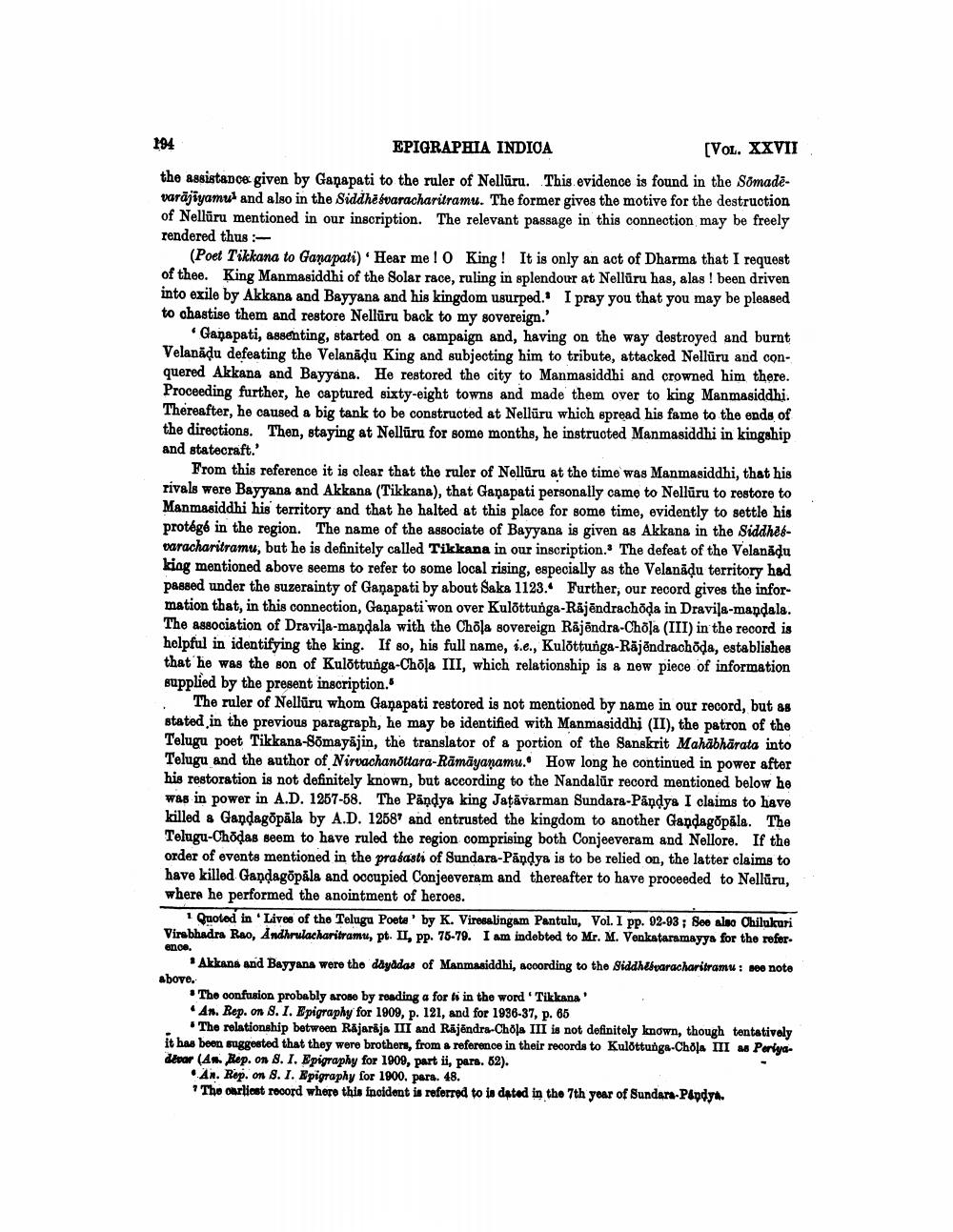________________
194
EPIGRAPHIA INDICA
[VOL. XXVII
the assistance given by Ganapati to the ruler of Nelluru. This evidence is found in the Sōmadevarajiyamu1 and also in the Siddhesvaracharitramu. The former gives the motive for the destruction of Nelluru mentioned in our inscription. The relevant passage in this connection may be freely rendered thus:
(Poet Tikkana to Ganapati) Hear me ! 0 King! It is only an act of Dharma that I request of thee. King Manmasiddhi of the Solar race, ruling in splendour at Nelluru has, alas ! been driven into exile by Akkana and Bayyana and his kingdom usurped. I pray you that you may be pleased to chastise them and restore Nelluru back to my sovereign.'
Ganapati, assenting, started on a campaign and, having on the way destroyed and burnt Velanādu defeating the Velanaḍu King and subjecting him to tribute, attacked Nelluru and conquered Akkana and Bayyana. He restored the city to Manmasiddhi and crowned him there. Proceeding further, he captured sixty-eight towns and made them over to king Manmasiddhi. Thereafter, he caused a big tank to be constructed at Nelluru which spread his fame to the ends of the directions. Then, staying at Nelluru for some months, he instructed Manmasiddhi in kingship and statecraft.'
From this reference it is clear that the ruler of Nelluru at the time was Manmasiddhi, that his rivals were Bayyana and Akkana (Tikkana), that Ganapati personally came to Nelluru to restore to Manmasiddhi his territory and that he halted at this place for some time, evidently to settle his protégé in the region. The name of the associate of Bayyana is given as Akkana in the Siddhesvaracharitramu, but he is definitely called Tikkana in our inscription. The defeat of the Velanādu king mentioned above seems to refer to some local rising, especially as the Velanādu territory had passed under the suzerainty of Ganapati by about Saka 1123. Further, our record gives the information that, in this connection, Ganapati won over Kulottunga-Rajendrachōda in Dravila-mandala. The association of Dravila-mandala with the Chōla sovereign Rajendra-Chola (III) in the record is helpful in identifying the king. If so, his full name, i.e., Kulottunga-Rajendrachōda, establishes that he was the son of Kulottunga-Chōla III, which relationship is a new piece of information supplied by the present inscription.
The ruler of Nelluru whom Ganapati restored is not mentioned by name in our record, but as stated in the previous paragraph, he may be identified with Manmasiddhi (II), the patron of the Telugu poet Tikkana-Somayajin, the translator of a portion of the Sanskrit Mahabharata into Telugu and the author of Nirvachanottara-Ramayanamu. How long he continued in power after his restoration is not definitely known, but according to the Nandalur record mentioned below he was in power in A.D. 1257-58. The Pandya king Jaṭavarman Sundara-Pandya I claims to have killed a Gandagopala by A.D. 1258" and entrusted the kingdom to another Gandagopala. The Telugu-Chodas seem to have ruled the region comprising both Conjeeveram and Nellore. If the order of events mentioned in the prasasti of Sundara-Pandya is to be relied on, the latter claims to have killed Gandagopala and occupied Conjeeveram and thereafter to have proceeded to Nelluru, where he performed the anointment of heroes.
1 Quoted in 'Lives of the Telugu Poete' by K. Viresalingam Pantulu, Vol. I pp. 92-93; See also Chilukuri Virabhadra Rao, Andhrulacharitramu, pt. II, pp. 75-79. I am indebted to Mr. M. Venkataramayya for the refer.
ence.
Akkana and Bayyans were the dayddas of Manmasiddhi, according to the Siddhebvaracharitramu: see note
above.
The confusion probably arose by reading a for ti in the word 'Tikkana'
An. Rep. on 8. I. Epigraphy for 1909, p. 121, and for 1936-37, p. 65
The relationship between Rajaraja III and Rajendra-Chola III is not definitely known, though tentatively it has been suggested that they were brothers, from a reference in their records to Kulottunga-Chola III as Periyadevar (An. Rep. on S. I. Epigraphy for 1909, part ii, para. 52).
An. Rep. on 8. I. Epigraphy for 1900. para. 48.
The earliest record where this incident is referred to is dated in the 7th year of Sundara-Pandya.




